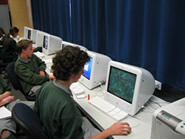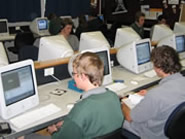Delivery

Screenshot from Paul's worms presentation
In the first three one-term units, students worked on individual projects, in which students learnt to use a variety of software packages, learnt about typography and design principles and how to use a visual diary to design and to develop concept ideas. In term four, the students formed into groups and worked together on a more loosely-defined collaborative project.
Steve and Malcolm gradually exposed students to the three components of technological practice thereby creating the working context for the projects and shaped the way students approached them. The first term focussed on 'Planning for Practice' and 'Outcome Development and Evaluation', the second focussed on 'Brief Development'.
The first project, in term one, was to design and produce the label and cover documentation for a backup CD Rom which eventually contained all of the work each student created during the year. Students learnt Freehand, a vector drawing programme, and the principles of typography and print design, which enabled them to produce high quality printed material.

The student instructions (pdf 204Kb) for this first unit were fairly explicit, Steve says. This was because the first term's project was quite guided while subsequent projects became less guided -all part of the theme of progression.
In the second unit of work (pdf 64Kb), students were taught how to create a kiosk PowerPoint presentation. After choosing a topical ICT issue (viruses, spam, e-crime, etc), and researching it, students created a PowerPoint presentation about their topic. In creating their screen presentation, students applied the design and typography concepts learnt in the previous unit. They also learnt how to manipulate digital images using Fireworks to enhance their presentation through the use of animations and text effects.
Steve says dealing with topical ICT issues like spamming and viruses allowed for experimentation with "Nature of Technology" material.

Screenshot from Ashley's website
During the third term, attention turned to web design (pdf 272Kb). Students were introduced to the web publishing program Dreamweaver through a series of teacher demonstrations and student worksheets. They also learnt how to use its associated image processing program Fireworks to create animated gifs for the web. Students built on their knowledge of typography and design, acquired in the first two units of work, by studying website planning and design. This led into the project for the term - the creation of a website detailing the development of the computer and its two-way interaction with society.
By exploring the impact computers have on modern life and the impact that events such as World War 2 and the 'Space Race' had on the development of the computer, the topic introduces the 'Nature of Technology' strand into the programme.
Students were given much less guidance in the term three project than they were in term one, Steve says.
"This is where one aspect of the progression comes in, as students have to have a deeper understanding of the particular component in order to be able to integrate it into their practice without teacher guidance."
The final term began with a burst of short exercises on creativity; then, after tuition in the use of Mac movie editing software iMovie and iDVD, the class moved into groups to focus on the final 'Digital Creativity' project.

In teaching terms, the aim of unit four was to "consolidate the technological practice, domain knowledge and skills base developed over the first three terms." In simpler terms, the aim was to have students cut loose with everything they had learnt in the year and really show it off.
In designing and delivering the programme, Steve and Malcolm had to be mindful of their assessment obligations, and so methods of assessing how students were grasping the three Components of Practice were carefully integrated into the year's programme. In term one, assessment focussed on the 'Planning for Practice' and 'Outcome Development and Evaluation' Components of Practice. From term two 'Brief Development' was assessed as well. Assessment criteria were based on Level Five of the Technology Curriculum.